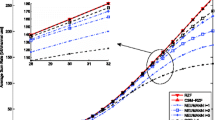Abstract
Massive multiple-input multiple-output (MIMO) technology is a promising technique having a high spectral efficiency for future wireless systems. Counterintuitively, the practical issues of transmitted signals are being attenuated by fading, propagation limitations, and implement non-linear precoding are solved by enlarging system dimensions. However, the computational complexity of precoding grows with the system dimensions. The existence block diagonalization (BD) precoding, which completely pre-cancels the multiuser interference is very complicated to implement with the use of a large number of BS antennas, since it considers full multiplexing order. Motivated by the high performance of the BD and generalized for the case when the users have multiple antennas, we propose a structure blocks based on iterative QR decompositions (IQRDs) to compute the precoding scheme. The proposed BLIQR-based precoder designed partitioned the channel matrix into capable square-wise blocks matrix and the IQRDs are applied to the blocks channel matrix. The channel matrix is partitioned such that it can fulfill the multiplexing order for the use in Massive MIMO. The computational complexity of the proposed design is effectively reduced and the sum-rate performance is improved, especially in large number of BS antennas. The performance of the proposed scheme achieves a good trade-off between throughput and computational complexity.






Similar content being viewed by others
References
Cisco. (2017). Cisco visual networking index: Global mobile data traffic forecast update, 2016–2021. White paper.
Hassan, N., & Fernando, X. (2017). Massive MIMO wireless networks: An overview. Electronics, 6(63), 1–29.
Ericson. (2013). 5G radio access, research and vision. White paper.
Marzetta, T. L. (2010). Noncooperative cellular wireless with unlimited numbers of base station antennas. IEEE Journal of Transactions on Wireless Communications, 9(11), 3590–3600.
Rusek, F., Persson, D., Lau, B. K., Larsson, E. G., Marzetta, T. L., Edfors, O., et al. (2013). Scaling up MIMO: Opportunities and challenges with very large arrays. IEEE Journal of Signal Processing Magazine, 30(1), 40–60.
Hoydis, J., ten Brink, S., & Debbah, M. (2013). Massive MIMO in the UL/DL of cellular networks: How many antennas do we need? IEEE Journal on Selected Areas Communications, 31(2), 160–171.
Hosseini, K., Hoydis, J., ten Brink, S., & Debbah, M. (2013). Massive MIMO and small cells: How to densify heterogeneous networks. In IEEE international conference on communications (ICC).
Bjornson, E., Kountouris, M., & Debbah, M. (2013). Massive MIMO and small cells: Improving energy efficiency by optimal soft-cell coordination. In IEEE international conference on telecommunications (ICT).
Bjornson, E. (2016). Radio resource management in massive MIMO communication systems. Linkoping: Linkoping University.
Ngo, H. Q. (2015). Massive MIMO: Fundamentals and system designs (Vol. 1642). Linkoping: Linkoping University Electronic Press.
Feng, C., & Jing, Y. (2016). Modified MRT and outage probability analysis for massive MIMO downlink under per-antenna power constraint. In IEEE international signal processing advances in wireless communication workshop (SPAWC) (pp. 1–6).
Park, C. S., Byun, Y. S., Bokiye, A. M., & Lee, Y. H. (2014). Complexity reduced zero-forcing beamforming in massive MIMO systems. In IEEE information theory and applications workshop (ITA) (pp. 1–5).
Ren, Y., Xu, G., Wang, Y., Su, X., & Li, C. (2015). Low-complexity ZF precoding method for downlink of massive MIMO systems. IEEE Journal of Electronics Letter, 51(5), 421–423.
Khansefid, K., & Minn, H. (2015). Achievable downlink rates of MRC and ZF precoders in massive MIMO with uplink and downlink pilot contamination. IEEE Journal of Transactions on Communications, 63(12), 4849–4864.
Tran, L. N., Bengtsson, M., & Ottersten, B. (2012). Iterative precoder design and user scheduling for block-diagonalized systems. IEEE Journal of Transactions on Signal Processing, 60(7), 3726–3739.
Zhang, C., Wang, B., Li, D., & Tan, X. (2015). Low complexity multiuser detection with recursively successive zero-forcing and SIC based on nullspace for multiuser MIMO-OFDM system. IEEE Journal of China Communications, 12(9), 53–63.
Spencer, Q., Swindlehurst, A., & Haardt, M. (2004). Zero-forcing methods for downlink spatial multiplexing in multiuser MIMO channels. IEEE Transactions on Signal Processing, 52(2), 461–471.
Hunger, R. (2007). Floating point operations in matrix-vector calculus. Techneische Universitat Munchen Associate Institute for Signal Processing, Technical Report.
Bjornson, E., & Jorswieck, E. (2013). Optimal resource allocation in coordinated multi-cell systems. Foundations and Trends in Communications and Information Theory, 9(2–3), 113–381.
Author information
Authors and Affiliations
Corresponding author
Additional information
Publisher's Note
Springer Nature remains neutral with regard to jurisdictional claims in published maps and institutional affiliations.
Rights and permissions
About this article
Cite this article
Mok, L.S., Noordin, N.K., Sali, A. et al. Low Complexity Iterative-QR (IQR) Precoder Design Based on Structure Blocks for Massive MIMO System. Wireless Pers Commun 102, 19–30 (2018). https://doi.org/10.1007/s11277-018-5822-2
Published:
Issue Date:
DOI: https://doi.org/10.1007/s11277-018-5822-2




